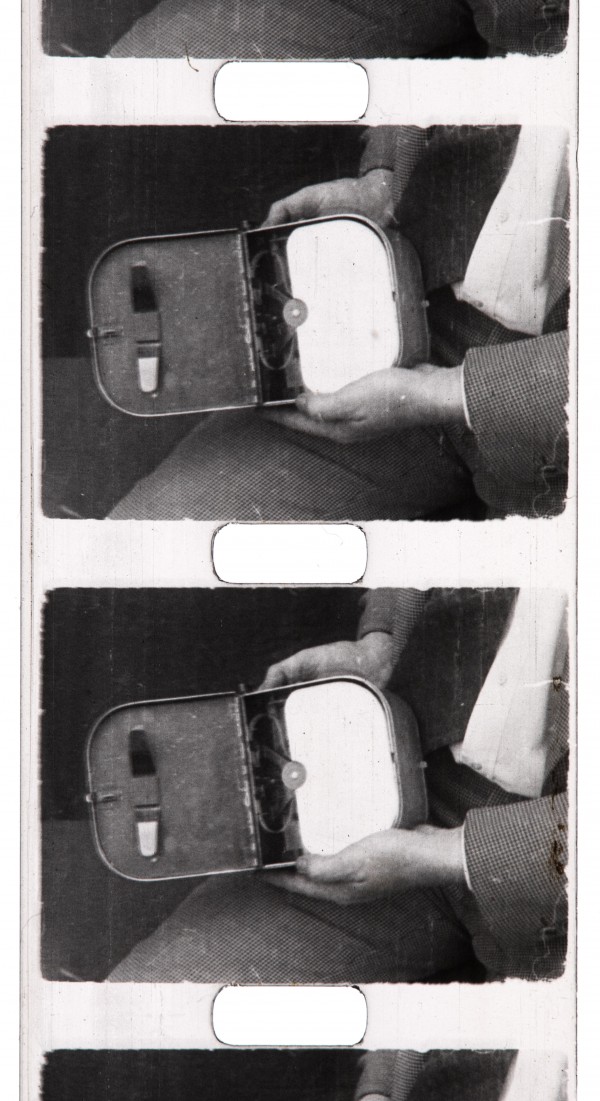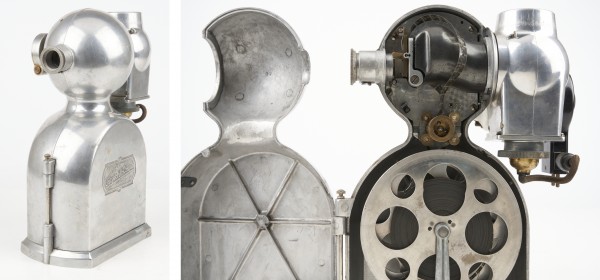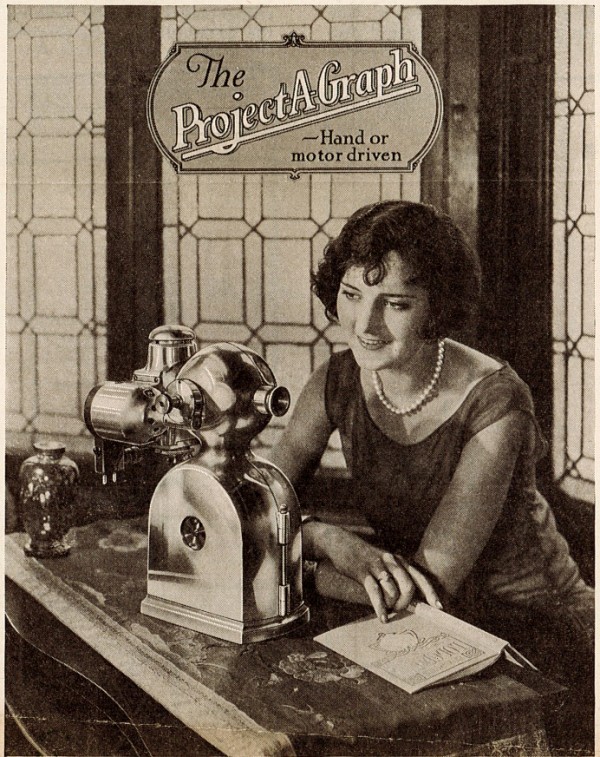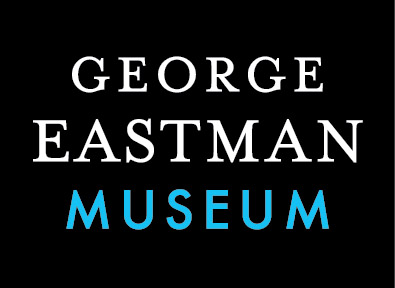Duplex Amateur Outfit(1924–1927)
An amateur camera-projector system produced by the Duplex Motion Picture Industries which used 11.6mm center-perforated diacetate film.
Film Explorer

11.6mm-wide (0.457 in), center-perforated Duplex film. Key to Duplex marketing was the format’s ability to conveniently film home movies. This image from the Duplex sampler reel was introduced with the title: “Your pets and all sorts of animal life portrayed at will”.
George Eastman Museum, Rochester, NY, United States.

The Kosher Adventures of P. Percy Pig (1927) excerpt from the Duplex sampler reel. Duplex promised “an immense variety of subjects” for its film library, including cartoons, travelogues, comedies, and documentaries reduction-printed from 35mm.
George Eastman Museum, Rochester, NY, United States.

A tinted-and-toned clip from the Duplex sampler reel, titled “Views of Atlantic City from a Flying Boat” (1927).
George Eastman Museum, Rochester, NY, United States.

The “Bathing Beauties” of Atlantic City, from the Duplex sampler reel (1927).
George Eastman Museum, Rochester, NY, United States.
Identification
11.5mm x 10.0mm (0.453 in x 0.394 in).
B/W
None
1
B/W (some prints were tinted).
None
Silent
10.8mm x 8.0mm (0.425 in x 0.315 in).
B/W
Unknown
History
The Duplex Amateur Outfit was a short-lived, small-gauge camera-projector system which used 11.6mm (0.457 in) center-perforated cellulose diacetate film. As the name suggests, the system was created by Duplex Motion Picture Industries (initially known as the Duplex Machine Company) – a corporation which produced and sold film industry machinery in the first third of the twentieth century. Duplex founder Herbert Oswald Carleton, was an inventor and cinematographer born in Rochester, New York, to Swedish émigré parents, who, with the involvement of his brothers Charles, George and Walter, formed the company in the early 1900s. First housed in the basement of the Carleton’s home in Brooklyn, the company soon expanded to a manufacturing plant on 75th Street, Brooklyn, later moving to an even larger location in Long Island City. Presumably named after the their first innovation, a step printer which allowed two prints to be struck simultaneously, the Duplex Machine Company began producing a robust line of film industry equipment, including “automatic printers, polishing machines, perforating machines, splicing blocks, measuring machines, special grinders, tripods, cameras, automatic light change devices, rewinding and measuring sets, rewinders for reels, dummies for reels and negative rewinders” (Moving Picture World, 1914; Moving Picture World, 1915; Moving Picture World, 1923; Brooklyn Citizen, 1924).
As a natural addition to this comprehensive product line, Duplex soon commenced plans to market an amateur film package of equipment, consisting of a camera (the “Photoscope”) and a projector (the “Project-A-Graph”), both designed to be used with 11.6mm center-perforated diacetate film. Despite Charles H. Carleton’s assertion that the Duplex Amateur Outfit was available as early as 1915, advertisements released by the company (all existing examples of which, it should be noted, are directed at dealers, not consumers) point to a much later date for the system’s debut. On May 5, 1924, an issue of the promotional periodical Duplex Progress announced: “All the necessary tools, jigs and dies for the manufacture of the Project-A-Graph are well under way, in fact, most of them completed and quantity production in 5,000 lots will begin in the near future.” By the end of June, a definite date had been announced: “On and after November 1, 1924, we expect to be in a position to deliver Project-A-Graphs in any quantity desired, and furnish both equipment and pictures for the Christmas trade.” However, on November 1, the projector had still not been released, with the company’s relocation from Brooklyn to Long Island City being blamed for the delay. “Now that we are located in the present building,” the Duplex Progress reported, “the speed with which the parts will be made within the next few months will be truly amazing” (Anon., 1924; Carleton, 1955).
While the Photoscope and most of the other Duplex products were the invention of Herbert Carleton and his brothers, the Project-A-Graph was created by Gerald J. Badgley, a mechanic and sometime actor, who likely met Herbert through their mutual involvement with the Thanhouser Company in New Rochelle, New York. Encased in a shiny, globular metal shell, the Project-A-Graph was a visually striking piece of machinery, if somewhat mechanically conventional. Very little is known about the Photoscope camera, and marketing focused almost exclusively on the Project-A-Graph and an anticipated library of Duplex films, which aimed to cover “an immense variety of subjects”. The size of the projector’s reels, as well as surviving prints, indicate that up to 400-ft (121.92m) films were sold – but details regarding the cost of the outfit, its commercial availability, and the complete list of marketed film library titles remain elusive (Duplex Motion Picture Industries, 1924b; Badgley, 1924; Bowers, 1995).
Regardless of when the Duplex Amateur Outfit was initially made available and the details of its marketing strategy, the lifespan of the format was predictably short. While the design of the 11.6mm gauge shared more than a passing resemblance to Pathé’s 9.5mm Pathé-Baby, like many small-gauge formats of the early 1920s, it was the meteoric rise in popularity of Kodak’s game-changing 16mm format that likely contributed to the failure of the Duplex amateur system. In January 1926 the Project-A-Graph was not mentioned in an Exhibitor’s Trade Review article specifically covering the variety of Duplex equipment, and by March of the following year, The Film Daily was reporting on a new line of Duplex 16mm perforators, slitters, and printers. Although the Carleton Brothers and Gerald Badgley would continue to innovate motion picture equipment individually, Duplex Motion Picture Industries itself went out of business in 1932, embroiled in a lengthy patent infringement court battle with Gaumont (United States District Court, ED. New York, 1932). In the years since the format’s demise, the details of the Duplex Amateur Outfit have often been confused and mistaken, likely stemming from the company’s common name and a 1930 Movie Makers article which contained multiple inaccuracies (among them: misidentifying a photo of the Project-A-Graph and claiming Duplex film had “two round perforations on each side of the picture”). Because of this, care should be taken when researching the format (Bernstein, 1926; Film Daily, 1927; Film Daily, 1932; Crawford, 1930).
Selected Filmography
Documentary footage. Original title unknown. Print conserved at George Eastman Museum, Rochester, NY, United States.
Documentary footage. Original title unknown. Print conserved at George Eastman Museum, Rochester, NY, United States.
Documentary footage. Original title unknown. Print conserved at George Eastman Museum, Rochester, NY, United States.
Documentary footage. Original title unknown. Print conserved at George Eastman Museum, Rochester, NY, United States.
Documentary footage. Original title unknown. Print conserved at George Eastman Museum, Rochester, NY, United States.
Documentary footage. Original title unknown. Print conserved at George Eastman Museum, Rochester, NY, United States.
Documentary footage. Original title unknown. Print conserved at George Eastman Museum, Rochester, NY, United States.
Documentary footage. Original title unknown. Print conserved at George Eastman Museum, Rochester, NY, United States.
Documentary footage. Original title unknown. Print conserved at George Eastman Museum, Rochester, NY, United States.
Documentary footage. Original title unknown. Print conserved at George Eastman Museum, Rochester, NY, United States.
Documentary footage. Original title unknown. Print conserved at George Eastman Museum, Rochester, NY, United States.
Documentary footage. Original title unknown. Print conserved at George Eastman Museum, Rochester, NY, United States.
Documentary footage. Original title unknown. Print conserved at George Eastman Museum, Rochester, NY, United States.
Documentary footage. Original title unknown. Print conserved at George Eastman Museum, Rochester, NY, United States.
Documentary footage. Original title unknown. Print conserved at George Eastman Museum, Rochester, NY, United States.
Documentary footage. Original title unknown. Print conserved at George Eastman Museum, Rochester, NY, United States.
Print conserved at George Eastman Museum, Rochester, NY, United States.
Print conserved at George Eastman Museum, Rochester, NY, United States.
Print conserved at George Eastman Museum, Rochester, NY, United States.
Print conserved at George Eastman Museum, Rochester, NY, United States.
Technology
Duplex film was produced by slitting non-flammable (diacetate-base) 35mm film into three strips, and then running the strips through a custom perforator. In addition to slitters and perforators, which only required new punches and dies to handle the 11.6mm film (0.457 in), Duplex adapted a number of their other products - including contact printers and reduction printers – to use with the new format (Carleton, 1955; Godfrey, 1955).
Scant information exists regarding the Duplex Photoscope camera, however the existing images suggest that it was hand-cranked rather than employing a spring-drive mechanism. It is unknown whether the film produced for the Photoscope camera was reversal, or negative. As for the Project-A-Graph, Gerald J. Badgley submitted multiple patents which covered the projection mechanism, the optional hand-crank operation, and the ornamental chrome casing. The engineering of the Project-A-Graph was relatively uncomplicated: a sprocket beneath the pressure plate on the gate drove the intermittent motion, while two other sprockets (with two rollers each) were positioned immediately above the payout and take-up reels – housed in the bottom half of the projector – to control the film path.

The Photoscope was Duplex's camera component of their amateur outfit. This shot of the device and the title that precedes it are the only known records of its existence, as not one piece of surviving advertising, publicity, or other material, mentions the Photoscope.
George Eastman Museum, Rochester, NY, United States.

The Project-A-Graph projector, one half of the Duplex Amateur Outfit. Both the projector mechanism and the metal casing were designed by Gerald J. Badgley. The George Eastman Museum’s Project-A-Graph and Duplex film collection were donated by a relative of the company founder, H. O. Carleton
Technology Department, George Eastman Museum, Rochester, NY, United States. Photograph by Ira Srole.
References
Bernstein, A. (1926). “The House of Variety”. Exhibitors Trade Review , 19:11 (Jan. 30): p. 17.
Bowers, David Q. (1995). “Badgley, Gerald J.” https://www.thanhouser.org/tcocd/Biography_Files/h8c0i7.htm
Brooklyn Citizen (1924). “Moving Pictures In Every Home”. The Brooklyn Citizen (Mar. 2): p. 8.
Carleton, Charles (1955a). Correspondence from Charles H. Carleton to Glenn E. Matthews, Sun Valley, CA (May 23). Moving Image Department, George Eastman Museum, Rochester, NY, United States.
Carleton, Charles (1955b). Correspondence from Charles H. Carleton to Glenn E. Matthews, Sun Valley, CA (Jun. 17). Moving Image Department, George Eastman Museum, Rochester, NY, United States.
Crawford, Merritt (1930). “The First Thirty Years”. Movie Makers, 5:12 (Dec.): pp. 755–7, 783–5.
Duplex Motion Picture Industries (1924a). “Quantity Productions Starts Soon”. Duplex Progress, 1:7 (May 5): p. 1. Kodak Patent Collection, Technology Department, George Eastman Museum, Rochester, NY, United States.
Duplex Motion Picture Industries (1924b). “Project-A-Graphs”. Duplex Progress, 1:8 (June 30): p. 2. Kodak Patent Collection, Technology Department, George Eastman Museum, Rochester, NY, United States.
Duplex Motion Picture Industries (1924c). “Project-A-Graph Inquiries Coming In”. Duplex Progress, 1:9 (Nov. 1): p. 6. Kodak Patent Collection, Technology Department, George Eastman Museum, Rochester, NY, United States.
Film Daily (1927). “Duplex Designing New Lines”. The Film Daily, 39:66 (Mar. 20): p. 10.
Film Daily (1932). “Dyke Cinema Products Handling Duplex Line”. The Film Daily 58:25 (Jan. 31): p. 6.
Godfrey, D. F. (1955). Correspondence from D. F. Godfrey to Glenn E. Matthews, Sun Valley, CA (May 9). Moving Image Department, George Eastman Museum, Rochester, NY, United States.
Moving Picture World (1914). “New Film Printer”. Moving Picture World, 22:5 (Oct. 31): p. 639.
Moving Picture World (1915). “Duplex Machine Company Enlarges Plant”. Moving Picture World, 24:13 (Jun. 26): p. 2113.
Moving Picture World (1923). “Duplex Expanding Business; To Build Modern Laboratory”. Moving Picture World, 65:9 (Dec. 29): p. 808.
United States District Court, Eastern Districts. New York (1932). “CINEMA PATENTS v. DUPLEX MOTION PIC. INDS., (E.D.N.Y. 1932) (Feb. 2) https://www.casemine.com/judgement/us/5914cd18add7b0493480fcc8/amp
Vitalux Cinema Company (1914). “The Project-A-Graph”. Long Island City, NY: Vitalux Cinema Company.
Patents
Badgley, G. J. Motion Picture Projector. US patent US1674629A, filed May 23, 1924, and issued June 26, 1928. https://patents.google.com/patent/US1674629A
Badgley, G. J. Casing for Motion Picture Projectors. US patent US69554S, filed May 23, 1924, and issued March 2, 1926. https://patents.google.com/patent/USD69554S
Badgley, G. J. Motion Picture Projector. US patent US1809327A, filed July 23, 1924, and issued June 9, 1931. https://patents.google.com/patent/US1809327A
Compare
Related entries
Author
Kirk McDowell is a film archivist interested in short-lived and experimental amateur film systems. As Assistant Collection Manager in the Moving Image Department of the George Eastman Museum, he helps care for over 100,000 reels in the archive’s collection, facilitates donations, handles nitrate and safety shipments and teaches small-gauge film inspection. He is a 2018 graduate of the L. Jeffrey Selznick School of Film Preservation and has previously held positions at the National Audio-Visual Conservation Center, Library of Congress, and the Wisconsin Center for Film and Theater Research.
Peter Bagrov, Deborah Stoiber, Sophia Lorent, Oleksandr Teliuk.
McDowell, Kirk (2025). “Duplex Amateur Outfit”. In James Layton (ed.), Film Atlas. www.filmatlas.com. Brussels: International Federation of Film Archives / Rochester, NY: George Eastman Museum.



